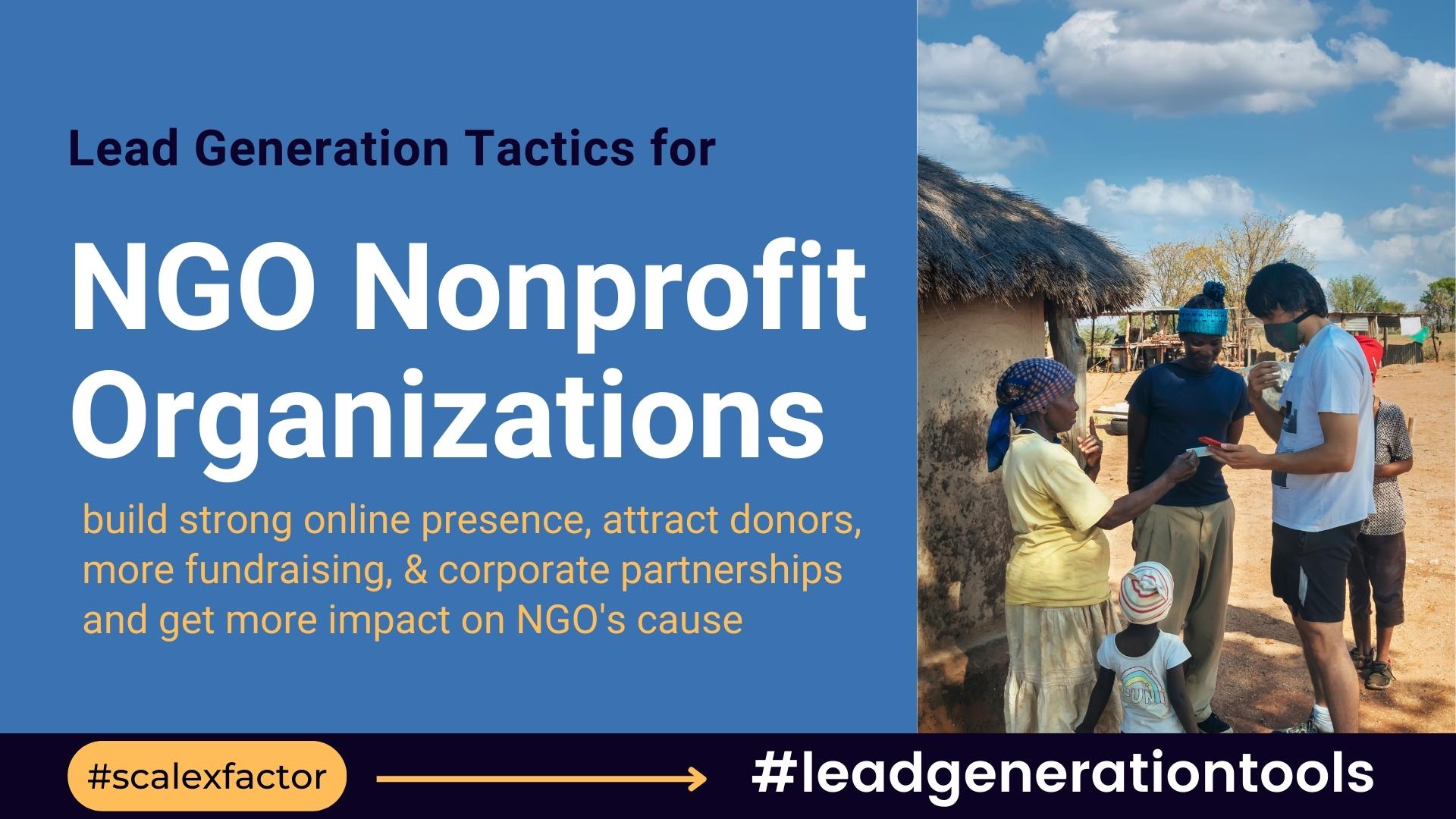As a nonprofit organization, effectively generating leads is crucial for raising awareness, attracting donors, and expanding your support base. In this comprehensive guide, we will explore various lead generation tools and strategies tailored specifically for nonprofits. From building a strong online presence to leveraging email marketing, partnerships, and more, we’ll cover the best practices to help your organization thrive and fulfill its mission.

Table of Contents
- Understanding Lead Generation for Nonprofit Organizations
- Building a Strong Online Presence for Nonprofits
- Crafting an Engaging Nonprofit Website
- Search Engine Optimization (SEO) for Nonprofits
- Utilizing Social Media for Nonprofit Outreach
- Content Marketing Strategies for Nonprofits
- Leveraging Email Marketing for Nonprofit Lead Generation
- Building a Targeted Email List for Donors
- Creating Compelling Email Campaigns for Supporters
- Personalization and Segmentation for Donor Engagement
- Collaborations and Partnerships for Nonprofits
- Networking with Other Nonprofits and Organizations
- Partnering with Corporations and Influencers
- Harnessing the Power of Content Marketing
- Creating Impactful Blog Posts and Articles
- Developing Educational Videos and Infographics
- Hosting Webinars and Virtual Events for Outreach
- Maximizing Social Media for Nonprofit Lead Generation
- Utilizing Facebook for Fundraising Campaigns
- Engaging Supporters on Twitter and Instagram
- Showcasing Your Cause on YouTube and TikTok
- The Role of Peer-to-Peer Fundraising
- Empowering Supporters as Fundraisers
- Implementing Peer-to-Peer Fundraising Campaigns
- Providing Recognition and Incentives for Participants
- Lead Magnets and Premium Content for Nonprofits
- Offering Valuable Resources to Supporters
- Providing Exclusive Content for Email Subscribers
- Using Lead Magnets for Donor Acquisition
- The Power of Corporate Social Responsibility (CSR) Partnerships
- Identifying and Approaching Potential CSR Partners
- Collaborating on Community Initiatives and Events
- Measuring the Impact of CSR Partnerships
- Hosting Engaging Virtual Events for Donor Acquisition
- Organizing Virtual Galas and Charity Auctions
- Hosting Virtual Run/Walk Fundraisers
- Planning Interactive Online Fundraising Events
- Utilizing Google Ad Grants for Nonprofit Lead Generation
- Applying for and Managing Google Ad Grants
- Creating Effective Google Ad Campaigns
- Tracking and Analyzing Ad Performance
- Measuring Success and Optimizing Lead Generation Strategies
- Setting Key Performance Indicators (KPIs) for Lead Generation
- Analyzing Data and Identifying Opportunities
- Continuously Improving and Adapting Strategies
1. Understanding Lead Generation for Nonprofit Organizations
Before diving into lead generation tactics, let’s grasp the essence of the process. Lead generation for nonprofits involves attracting individuals who are interested in supporting your cause and nurturing them into committed donors or volunteers. This process is essential for sustaining your organization’s impact and growth.
2. Building a Strong Online Presence for Nonprofits
Crafting an Engaging Nonprofit Website
Your nonprofit website serves as a vital platform for engaging with potential donors and volunteers. Ensure your website is visually appealing, user-friendly, and clearly communicates your mission and impact.
Search Engine Optimization (SEO) for Nonprofits
Utilize SEO strategies to improve your website’s visibility on search engines. Conduct keyword research to target relevant long-tail keywords like “nonprofit supporting [your cause]” and incorporate them naturally into your website content.
Utilizing Social Media for Nonprofit Outreach
Engage with your audience through various social media platforms Facebook, Instagram and YouTube. Share compelling stories, impact updates, and calls-to-action to foster a sense of community among your supporters.
Content Marketing Strategies for Nonprofits
Create valuable and informative content, such as blog posts, articles, and videos, to educate your audience about your cause and the difference they can make by supporting your organization.
3. Leveraging Email Marketing for Nonprofit Lead Generation
Building a Targeted Email List for Donors
Offer incentives, such as exclusive content or updates, to encourage website visitors to subscribe to your email list. Targeted lists allow you to tailor your email campaigns to specific segments of your audience.
Creating Compelling Email Campaigns for Supporters
Design impactful email campaigns that inspire action and showcase the impact of donations. Use storytelling to connect emotionally with your recipients.
Personalization and Segmentation for Donor Engagement
Segment your email list based on donor interests and past interactions. Personalize your emails to make each supporter feel valued and connected to your cause.
4. Collaborations and Partnerships for Nonprofits
Networking with Other Nonprofits and Organizations
Build relationships with other nonprofits and community organizations. Collaborating on projects and events can help expand your reach and resources.
Partnering with Corporations and Influencers
Identify corporations and social media influencers aligned with your cause. Partnering with them can provide exposure and access to a wider audience.
5. Harnessing the Power of Content Marketing
Creating Impactful Blog Posts and Articles
Write blog posts and articles that address common questions and concerns related to your cause. Position your organization as a thought leader in the field.
Developing Educational Videos and Infographics
Produce informative videos and infographics to simplify complex issues and engage your audience visually.
Hosting Webinars and Virtual Events for Outreach
Conduct webinars on topics relevant to your cause and host virtual events to raise awareness and funds for your initiatives.
6. Maximizing Social Media for Nonprofit Lead Generation
Utilizing Facebook for Fundraising Campaigns
Leverage Facebook’s fundraising tools and create compelling campaigns to collect donations from supporters.
Engaging Supporters on Twitter and Instagram
Interact with your audience on Twitter and Instagram through retweets, comments, and compelling visuals.
Showcasing Your Cause on YouTube and TikTok
Utilize YouTube and TikTok to share impactful videos and engage with a younger audience passionate about social causes.
7. The Role of Peer-to-Peer Fundraising
Empowering Supporters as Fundraisers
Encourage your supporters to become fundraisers themselves by setting up peer-to-peer fundraising campaigns.
Implementing Peer-to-Peer Fundraising Campaigns
Provide resources and support to participants of peer-to-peer fundraising campaigns to ensure their success.
Providing Recognition and Incentives for Participants
Recognize and reward the top fundraisers to motivate others to participate in future campaigns.
8. Lead Magnets and Premium Content for Nonprofits
Offering Valuable Resources to Supporters
Create lead magnets such as e-books, toolkits, or guides that provide valuable information related to your cause.
Providing Exclusive Content for Email Subscribers
Reward email subscribers with exclusive content or early access to important updates.
Using Lead Magnets for Donor Acquisition
Use lead magnets strategically to attract potential donors and convert them into long-term supporters.
9. The Power of Corporate Social Responsibility (CSR) Partnerships
Identifying and Approaching Potential CSR Partners
Reach out to corporations aligned with your mission and propose mutually beneficial partnerships.
Collaborating on Community Initiatives and Events
Work together with CSR partners on community initiatives and events that support your cause.
Measuring the Impact of CSR Partnerships
Track and measure the impact of CSR partnerships to showcase their importance to your organization.
10. Hosting Engaging Virtual Events for Donor Acquisition
Organizing Virtual Galas and Charity Auctions
Host virtual galas and charity auctions to engage donors and raise funds for your cause.
Hosting Virtual Run/Walk Fundraisers
Organize virtual run/walk fundraisers to involve supporters in healthy activities while supporting your organization.
Planning Interactive Online Fundraising Events
Create interactive online fundraising events to keep donors engaged and excited about supporting your cause.
11. Utilizing Google Ad Grants for Nonprofit Lead Generation
Applying for and Managing Google Ad Grants
Take advantage of Google Ad Grants to access free advertising on Google Search.
Creating Effective Google Ad Campaigns
Craft targeted and compelling Google Ad campaigns to attract potential donors and volunteers.
Tracking and Analyzing Ad Performance
Monitor the performance of your Google Ad campaigns and adjust them based on data analysis.
12. Measuring Success and Optimizing Lead Generation Strategies
Setting Key Performance Indicators (KPIs) for Lead Generation
Establish measurable KPIs to track the success of your lead generation efforts.
Analyzing Data and Identifying Opportunities
Use data analysis to identify areas for improvement and new opportunities for lead generation.
Continuously Improving and Adapting Strategies
Stay agile and adapt your lead generation strategies based on insights and changing circumstances.
Conclusion
In conclusion, selection effective lead generation tools is a vital aspect of a successful nonprofit organization’s growth and impact. By leveraging various strategies, including building a strong online presence, utilizing email marketing, forming collaborations, creating impactful content, harnessing the power of social media, and optimizing lead generation efforts, your nonprofit can attract passionate supporters, engage donors, and make a meaningful difference in your cause. Stay committed to your mission, continuously refine your strategies, and embrace new opportunities to sustain long-term success for your organization.




